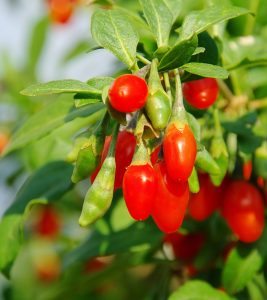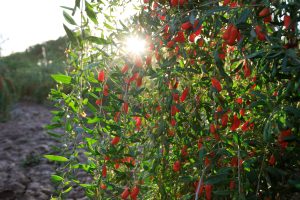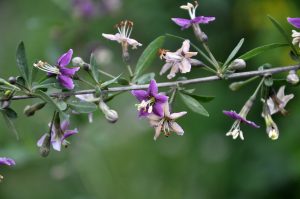
Goji berries, often hailed as a superfruit, have captured the world’s attention with their remarkable combination of health benefits and ease of cultivation. These small, red gems are celebrated for their exceptional nutritional profile and potent antioxidants, making them a popular choice among health-conscious individuals. What sets goji berries apart is their powerhouse of nutrients and their adaptability to various growing conditions, making them a practical and rewarding addition to any garden.
Right Plant, Right Place

The goji berry is a deciduous woody shrub native to the arid regions of Northwest China. This remarkably resilient plant exhibits a remarkable capacity to thrive even in conditions that deviate from its preferred environment. To determine the most suitable site for goji berry cultivation, conducting a soil test is strongly advised (for guidance on selecting the appropriate soil test, please refer to my blog, ‘Choosing the Right Soil Test‘). Goji berries flourish in soils with a pH ranging from 6.5 to 8.0 and show a preference for well-drained sandy/loam soils. It’s crucial to avoid planting this shrub in flood-prone or waterlogged areas. Like many fruit-bearing plants, goji berries thrive when positioned in locations that receive full sun exposure (6-8 hours). Given their impressive tolerance and adaptability to Florida’s soil conditions, identifying the ideal spot for this plant becomes a straightforward endeavor.
Cultivating a Healthy Bush
As goji berries mature into thorny shrubs reaching up to 12 feet in height and 4 feet in width, early maintenance is crucial to their long-term health and productivity. In the first year, minimal intervention is needed. Avoid pruning during this period, and if fertilization is desired, apply it 1-2 months after planting, or in the spring for late fall or winter plantings.
By the second year, you’ll want to focus on shaping the plant. If multiple trunks have developed, retain the healthiest one and remove any spindly or damaged branches. In early spring, when the plant reaches 16-18 inches, pinch the tip to encourage branch development. Keep a healthy upward shoot as the mainstem for the next year and maintain 3-5 branches for fruit production.
From the third year onward, winter becomes the time for maintaining the size and shape of your goji berry bush. Regular pruning not only keeps it in your desired form but also stimulates new growth, which is typically more productive. Ensure that no new shoots grow within the lower 12 inches of the trunk, as they are unlikely to yield fruit.
Goji berries can thrive in poor soils, but when it comes to fertilizer, less is often more. Using tomato fertilizers can work, but don’t overdo it. Too much fertilizer can lead to more leaves and less fruit. It’s all about finding the right balance for a healthy and productive goji berry plant.
Harvesting and Storing Goji Berries

Goji berries are a delightful addition to your garden, and knowing when and how to harvest them is crucial for enjoying their full flavor. These berries typically ripen about 35 days after flowering, and their flowering period can span several weeks. The best time to pick them is when they attain a deep red hue. Freshly harvested berries can be stored at room temperature for up to a week, or in the refrigerator for a maximum of two weeks. However, after two days at room temperature, they may start to show signs of drying out.
If you prefer dried goji berries, here’s a simple method: Leave the fruit at room temperature for 2 to 3 days, and then place them in the sun to finish the drying process. Avoid stirring or turning them over during drying, as this can lead to discoloration of the fruit. This method ensures you can enjoy the goodness of goji berries year-round.
The Power of Goji Berries: A Superfruit for Well-being
The goji berry’s exceptional status as a superfruit lies in its astonishing array of 355 physiologically active compounds, comprising a wealth of essential minerals, vitamins, and amino acids. These nutritional powerhouses offer a wide range of health benefits, including immune system enhancement, anti-aging properties, potential cancer and cardiovascular disease prevention, and support for weight management.

Exploring the benefits of the goji berry is as versatile as it is rewarding. These berries can be enjoyed fresh or dried, incorporated into jams, jellies, and cooked dishes. The leaves, in tandem with the berries, can be utilized in teas, yogurts, and various culinary creations. Additionally, the bark of the goji berry plant also finds its place in the world of teas, showcasing the multifaceted appeal of this remarkable superfruit. Unlock the potential of goji berries for a healthier, more vibrant life.
For more information about goji berries:
- GOJI BERRY—A NOVEL NUTRACEUTICAL “SUPERFRUIT” FOR FLORIDA MASTER GARDENERS UF/IFAS publication
- How can the Nutraceutical Superfruit Goji Berry be Grown in Florida – YouTube
- How to Grow Goji Berries In Your Garden Utah State University website
 8
8
